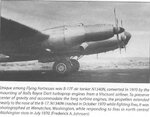GreenKnight121
Staff Sergeant
- 913
- Mar 16, 2014
Here is the un-adjusted photo of the Pratt-Whitney XT-34 testbed (B-17G-105-VE 44-85734).
The XT34 turboprop eventually went into production and ended up powering the Douglas C-133 Cargomaster long-range transport aircraft.
Following the completion of the tests in 1967, NX-5111N was donated to the Connecticut Aeronautical Historic Association based at Bradley International Airport. In 1979, it was heavily damaged in a tornado. In 1987, the damaged hulk was traded to Tom Reilly of Kissimmee, Florida, who plans to restore the aircraft to flying status in its original military configuration.
Note that the cockpit has been moved aft. :

And front view:

A Pratt & Whitney T64 turboprop was installed briefly to test different engine and propeller combinations.
The XT34 turboprop eventually went into production and ended up powering the Douglas C-133 Cargomaster long-range transport aircraft.
Following the completion of the tests in 1967, NX-5111N was donated to the Connecticut Aeronautical Historic Association based at Bradley International Airport. In 1979, it was heavily damaged in a tornado. In 1987, the damaged hulk was traded to Tom Reilly of Kissimmee, Florida, who plans to restore the aircraft to flying status in its original military configuration.
Note that the cockpit has been moved aft. :
And front view:
A Pratt & Whitney T64 turboprop was installed briefly to test different engine and propeller combinations.
Last edited:




